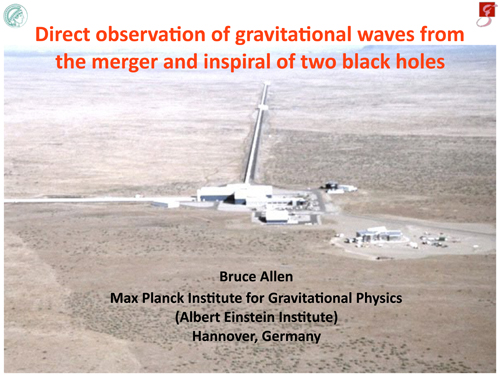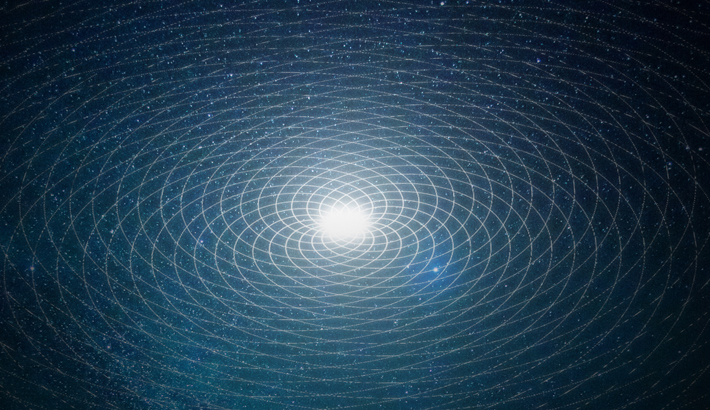Gravitational waves detected from black hole merger
For the first time, scientists have directly detected gravitational waves, ripples in the spacetime fabric of our universe predicted by Einstein's theory of general relativity. This type of radiation is generated by the violent dynamics of massive and compact astrophysical objects, such as black holes and neutron stars, or the very early stages, soon after the Big Bang, of our universe itself. In this case, the waves were created by the merger of two black holes approximately 1.3 billion years ago.
The announcement was made at a press conference held by the LIGO Scientific Collaboration on Thursday 11 February, ushering in a new era of gravitational astrophysics:
https://www.ligo.caltech.edu/detection
Gravitational waves are a particularly remarkable form of radiation because, in spite of carrying enormous amounts of energy, they pass nearly unimpeded through all the matter present in the universe and therefore give us the most pristine view of their sources. It is precisely this feature of gravitational waves, however, that makes their direct observation such a grand challenge for scientists. Using the latest laser technology and interferometry devices, a network of detectors composed of the two Laser Interferometer Gravitational-wave Observatory (LIGO) observatories at Hanford and Livingston (USA), the Virgo detector near Pisa (Italy), GEO600 at Hanover (Germany) and, up to 2004 also the Japanese TAMA 300, has been searching for well over a decade to see the enigmatic waves predicted by Einstein's theory. The patience of the scientists has finally paid off, now that LIGO, having resumed observation only last September after a five-year upgrade to "Advanced" status, has picked up a strong signal generated by the violent merger of two rather massive black holes.

The week after the announcement of the discovery, LIGO scientist Bruce Allen gave a talk on the results at the Centre for Mathematical Sciences.
(Photograph by Anna N. Zytkow.)
This result is of breathtaking significance: a completely new channel to observe and study the universe we live in. The prospects for new scientific insights are enormous, ranging from the exploration of the equation of state of matter at super nuclear densities in neutron stars, to unprecedented tests of Einstein's theory of general relativity, a census of black holes, these most bizarre residents in our universe, to probing the earliest moments of the universe itself, closer to the Big Bang that could ever be possible through electromagnetic observations. Add to this the potential for surprises that always come along with qualitatively new observation methods, and the excitement of the astrophysics community is likely to increase even further as the observation of a previously dark part of the universe's spectrum keeps gathering momentum.
Stephen Hawking BBC interview about LIGO
These discoveries are consistent with foundational developments made here in the Cambridge Relativity and Gravitation group, including those made by Stephen Hawking, who made the following statement during a BBC interview:
“I would like to congratulate the LIGO team on their ground breaking discovery. These results confirm several very important predictions of Einstein's Theory of General Relativity.
“It confirms the existence of gravitational waves directly. Until now, our observations of the Universe have exploited light, radio waves, and other electromagnetic radiation. Gravitational waves provide a completely new way of looking at the Universe. The ability to detect them has the potential to revolutionize astronomy.
“This discovery is the first detection of a black hole binary system, and the first observation of black holes merging. The observed properties of this system are consistent with predictions about black holes that I made in 1970 here in Cambridge. The area of the final black hole is greater than the sum of the areas of the initial black holes, as predicted by my black hole area theorem. The properties of these black holes are also consistent with the black hole no-hair theorem, which says that they should be uniquely characterized by their mass and spin.
“Previous tests of General Relativity, have almost exclusively applied to weak gravitational fields. This discovery lets us test the predictions of General Relativity, when the gravitational field is strong, and highly dynamical, during the black hole merger.
“This discovery also presents a puzzle for astrophysicists. The mass of each of the black holes are larger than expected for those formed by the gravitational collapse of a star. So how did both of these black holes become so massive? I am sure the LIGO team are going to keep us busy with many further surprises.
“Apart from testing General Relativity, we could hope to see black holes throughout the history of the universe. A cosmic distance ladder using these black holes, would be extremely accurate, and complement existing distance ladders, based for example on supernovas. From neutron star mergers, we will learn about the equation of state of matter, at super nuclear densities. We may even see relics of the very early universe, during the Big Bang, at the most extreme energies possible."
The video of Stephen Hawking’s BBC interview can be seen here:
http://www.bbc.co.uk/news/science-environment-35524440
LIGO results lecture by Professor Bruce Allen, Albert Einstein Institute Director
In a fascinating talk offering unique insights from a leader within the LIGO data analysis team, Bruce Allen spoke at the Centre for Mathematics Sciences on 17 February.

Professor Allen was a former PhD student of Stephen Hawking and a member of DAMTP from 1981-84. The details of his talk are below and the slides he presented can be downloaded in PDF form here.
Title: Direct observation of gravitational waves from the merger and inspiral of two black holes
Abstract: This talk follows the annoucement made on February 11th by the LIGO Scientific Collaboration. On September 14, 2015, we detected the gravitational waves emitted by the final few orbits and merger of two black holes. In this talk, I present the main results, as well as some of the "behind the scenes" details of the discovery and subsequent analysis. Reference: B. P. Abbott et al., Phys. Rev. Lett. 116, 061102, 2016.

